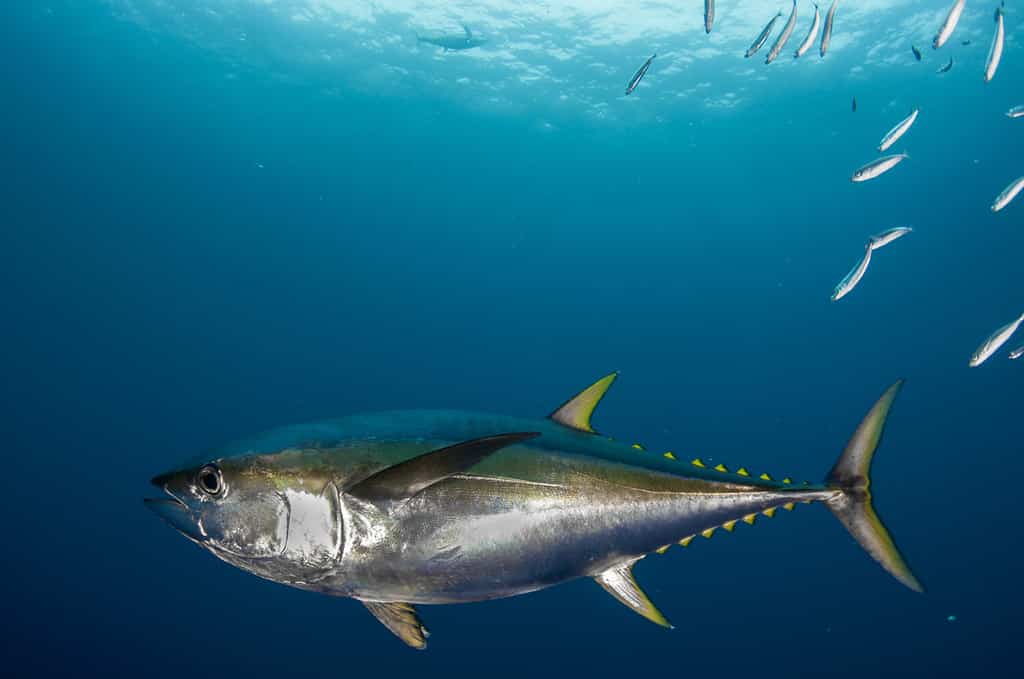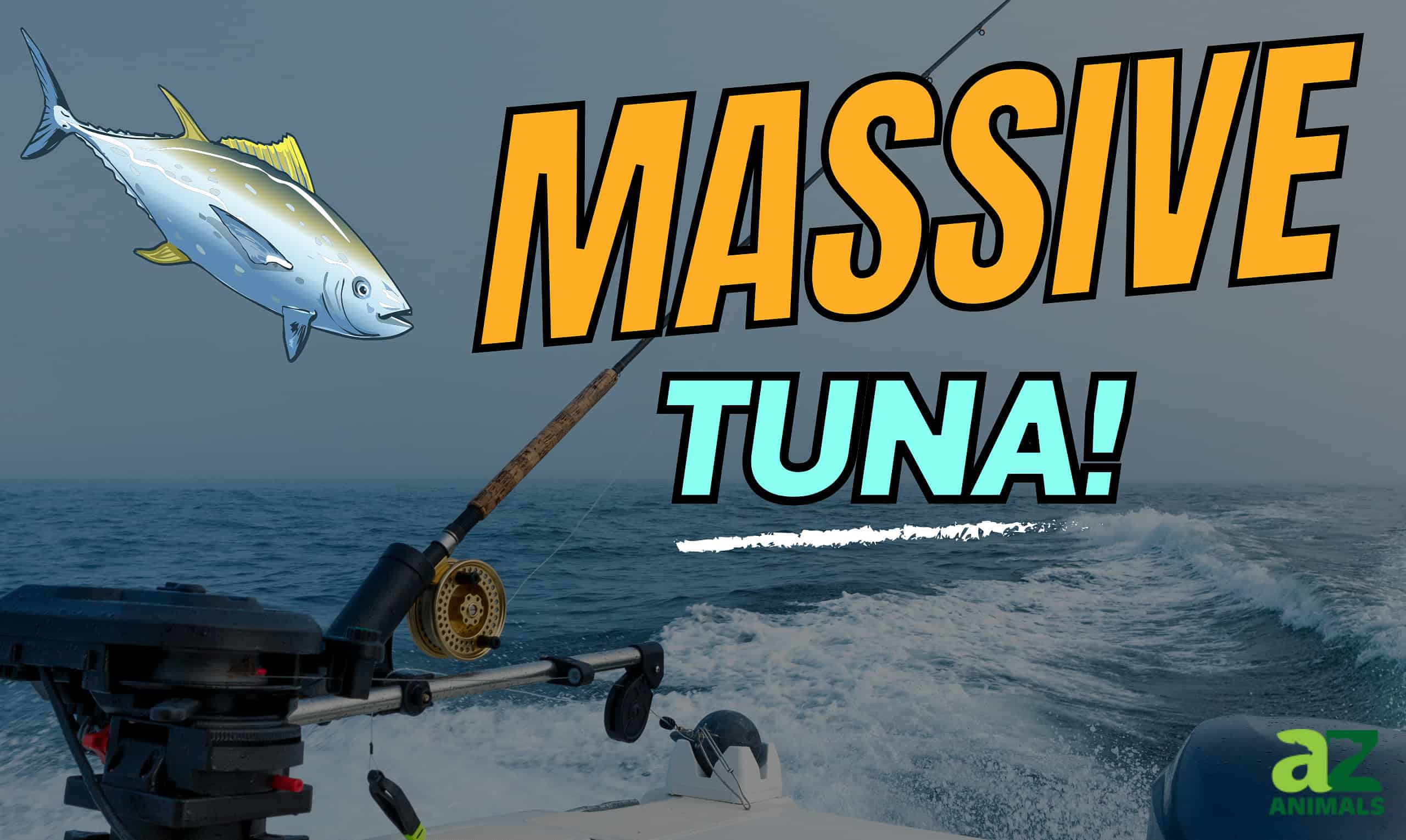If you’ve eaten tuna, there’s a good chance that you’ve had a tasty bite of yellowfin tuna. While not the largest of the tuna species (and some of them can get absolutely massive!), the yellowfin tuna is still an impressive fish. It has a mild flavor and is a bit easier to reel in than some other larger tuna species.
The largest yellowfin tuna ever reeled in by a fisherman and authenticated through the records process was 424 pounds. It was caught near Baja, Mexico by a fisherman named Jorge Lazo. It took around two hours to actually reel the massive fish in. Reports vary but this 424-pound tuna is the largest on record.
But the process to actually have the catch certified requires some extra steps so there are larger tuna catches out there that are documented but not certified. One angler fishing off the coast of Loreto in Baja California Sur, Mexico weighed his yellowfin tuna catch at 430 pounds. But before he authenticated the catch, he cleaned and fileted it. Unfortunately, that meant that it could no longer be certified and he just had bragging rights to go on. This might be the unofficial largest yellowfin ever caught. But the official record remains at 424 pounds.
Where Do Yellowfin Tuna Live?

The yellowfin tuna is one of the open ocean’s fastest, strongest predators and an important fishery species everywhere that it lives.
©Al McGlashan/Shutterstock.com
These fish live in many oceans throughout the world, including the Atlantic, Pacific, and Indian Oceans. Yellowfin tuna tend to stay near the surface of the water. This is good news for anglers looking to catch a yellowfin tuna. Just be ready for a fish with some fight. It may take a couple of hours to get the tuna onboard.
While yellowfin tuna are large, they’re nothing compared to the largest tuna ever caught. An Atlantic bluefin tuna weighing 1,496 pounds was caught near Nova Scotia in 1979. The impressive record remains more than 20 years later!
California is another popular place to fish for tuna. The largest yellowfin caught in California was 265 pounds. It was caught in 2017. Typically, these fish get to be around 100-180 pounds, although there are impressive individual fish who far exceed this amount. Yellowfin tuna in Hawaii are often called Ahi tuna. You’ll see this name on menus as well as at the grocery store when shopping for tuna. Ahi tuna also refers to bigeye tuna, another distinct species.
Bigeye tuna and yellowfin tuna are closer in size as well as lifespan, which is typically around 6 or 7 years. Their range does overlap and you can generally tell the difference between the two species by their coloring. Bigeye tuna are also a bit plumper than the sleek yellowfin.
What Do Yellowfin Tuna Look Like?

Yellowfin tuna are named for the bright yellow areas on their fins.
©Shane Gross/Shutterstock.com
These fish have the characteristic sleek body of a tuna. They move swiftly through the water thanks to their aerodynamic shape. They are dark blue on the back and yellowish-silver on their sides, just above their fins. As their name suggests, yellowfin tuna have yellow dorsal fins and anal fins on their backs.
Yellowfin tuna get up to 450 pounds on the high end. While this is a very large fish, it’s small compared to their relative, the bluefin tuna. These giants get over 1,000 pounds! Yellowfin and bluefin are some of the most popular and plentiful types of tuna to eat. You can tell the difference by their coloring as well as their size. Yellowfin tuna have yellow fins while bluefin tuna are blue all over with silvery sections on their bellies.
How to Catch Yellowfin Tuna

Yellowfin tuna often stay near the surface, making them a good sport fish for anglers.
©Al McGlashan/Shutterstock.com
Because they are large, you’ll need specialized deep-sea fishing gear that can handle the heavier load. Trolling is a popular way to fish for yellowfin tuna. There are also specific lures that work well, including tuna feathers and plastic trolling lures.
Yellowfin are apex predators in their environment and will go after other fish. Anglers can use this to their advantage when choosing bait. If you are fishing for tuna, live bait such as squid, sardines, or spot often have good results. A fishing charter can help you determine the best bait to use as well as provide deep-sea fishing equipment.
Fishing for tuna of all kinds is closely tracked to make sure that it is sustainable. While yellowfin tuna are not endangered, overfishing can create issues over time. They are classified as Near Threatened by the National Oceanic and Atmospheric Administration. Because fishing regulations are so thorough, however, the population is well managed. NOAA considers yellowfin tuna a sustainable seafood option.
Thank you for reading! Have some feedback for us? Contact the AZ Animals editorial team.








